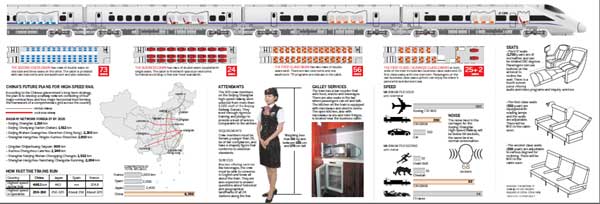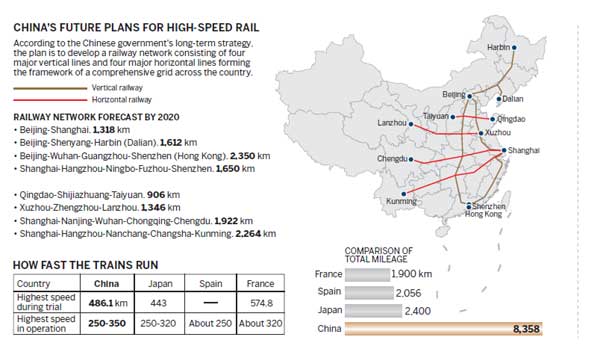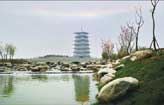Technology
Fast forward
Updated: 2011-07-08 11:09
By Xin Dingding (China Daily European Weekly)

High-speed trains keep China's economic engine chugging along Despite obstacles
Infrastructure construction took a giant leap in China earlier this month when after just 39 months, the $33 billion (23 billion euros), 1,318 km high-speed railway line started daily services between Beijing and the financial center of Shanghai. Though the high-speed rail service has been attracting lots of bouquets and brickbats in recent times, there is no denying the fact that it is an awe-inspiring network that spans nearly 10,000 km in length. That, in other words, is no mean feat considering that high-speed trains commenced operations only in 2007 with the 350-km per hour trains plying between Beijing and the neighboring port city of Tianjin.
The growth since then has been fast, much like the trains they represent. While the lengthy network stands testimony to these achievements, it is not surprising to recollect that the transition to such a network was not an easy one.


"Road transport often involves higher costs, as it uses more fuel than rail transport. With so many expressways laid out, it meant that China would have to import a lot of crude oil to support its road network. That, indirectly, would mean that China's economic lifeline is dependent on external sources," he says.
Many experts including Wang had at that time advocated for railway expansion to be undertaken at a similar pace to that of expressways. But there were also some experts who argued that the setting up of a large-scale high-speed rail network construction would pose severe financial risks.

Such doubts were not uncommon as high-speed rail network was still in its infancy in the rest of the world. Setting up these networks was an expensive proposition and few developed countries had tested the waters. Estimates from that period indicate that it would cost as much as 300 million to 400 million yuan (32.4 million to 43.2 million euros) to set up a kilometer of high-speed railway line.
Experts at that time felt that rather than invest in high-speed rail networks, China should focus on expanding the capacity of the existing railway lines and increasing the operating speed.
But others, like Shen Zhiyun, an academician at the Chinese Academy of Sciences and Chinese Academy of Engineering and one of the first supporters of high-speed rail networks, had a different opinion. Shen believed that construction of high-speed railway networks was feasible in terms of technology and funding.
"We felt that construction of such a network must start as early as possible. Delays would lead to incremental costs of 20 billion yuan every year," says Shen, who had proposed to start the high-speed railway construction during the Ninth Five-Year Plan (1996-2000).

Considering the early obstacles, it was no surprise then that the railway system lagged economic demand. Even in 2009, the railway ministry spokesman Wang Yongping had said that the existing network could support only 35 percent of the demand for freight transport. Wang had expected that the launch of high-speed railways could help free up of more space on the existing railway network to cope with the increased demand for freight transport.
The government decided to put high-speed railway network construction in its agenda during the early 1990s. Accordingly, it was decided that the services should ideally be started between Beijing and Shanghai.
In 2003, the State Planning Commission (then the country's top economic planner), the Ministry of Railways and three other government departments set up a research team comprising experts to study the proposal for the Beijing-Shanghai high-speed railway. By 2004, the team came up with its report that the line should be built as early as possible.
Though everything went off smoothly in the initial stages, there were still some nagging problems lingering from the past that needed to be addressed.
Scientists and the railway ministry had locked horns over the technology to be used for the trains. Opinion was divided over whether to use the wheel rail technology or the maglev technology.
Many felt that the line should use the maglev technology, as it was a more advanced technology. The advantages of using maglev technology included less friction loss and less noise, and the ability to increase or decrease speed within a short time.
But ministry officials and other experts felt that if they were to adopt the maglev technology, the Beijing-Shanghai link would be not able to link up with the existing network.
In 2003, the State Council, China's Cabinet, indicated that it preferred the wheel-rail technology to maglev, as it was more practical and less expensive to build.
The State Council also made it clear in a classified document that the high-speed rail construction should use imported advanced technologies from abroad.
At that time, the Ministry of Railways had also developed a high-speed train called "China Star" with a designed speed of 270 km per hour, but the train was found not reliable enough when running at a speed of over 200 km per hour and thus deemed not mature for commercial operation.
Dong Yan, a researcher at the comprehensive transport institute under the National Development and Research Commission (NDRC), says that his institute was asked to study problems including how to import high-speed rail technologies at the minimum price, which technologies to import, how to make good use of the imported technologies, and whether it was possible to build high-speed railways at 100 million yuan per kilometer, much lower than the cost in Japan and South Korea.

Specials

90th anniversary of the CPC
The Party has been leading the country and people to prosperity.

My China story
Foreign readers are invited to share your China stories.

Green makeover
Cleanup of Xi'an wasteland pays off for ancient city